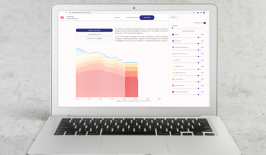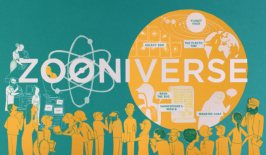For Daniel Staemmler, certain civic tech projects are clearly also a form of political protest. In an interview with RESET, we talked to him about such forms of protest and how political pressure can be built up with open data and its visualisation.

Daniel Staemmler is a research associate at Humboldt University Berlin’s Institute of Social Sciences and his research focuses on digital activism and political protest.
I would say that civic tech, in the first moment, consists in the fact that technology is developed – that there is a civic production of digital technology. So, applications, be they apps or platforms, are developed, operated, and kept online in order to present publicly what is actually possible with the resources of digitalisation.
I focus primarily on political civic tech projects. Classic examples are FragDenStaat (Ask the State) and, somewhat older, Abgeordnetenwatch (Parliament Watch). Recently, there is also Democracy, where you can vote on motions together with the Bundestag via an app. I argue that these are examples of what a digital democracy could actually look like today. These developments could therefore also be understood as digital democratic innovations that serve to demonstrate to the public how democratic procedures can not only be improved, but possibly also changed, through technological development.
What are digital democratic innovations?
Digital democratic innovations are primarily technical innovations for democratising political processes, such as decision-making or administrative offerings. In the case of politically oriented civic tech projects that advocate the values and ideas of open government, such processes can be captured by the term “feedback democracy.” The idea behind this is that we have information and communication technologies and the media that build on them, and therefore it must actually be possible to convert political communication between representatives, between ministries, between the administration in municipalities and the citizens much more to this many-to-many communication. This is the basic structure of offerings that has emerged together with the Internet, and that we are also used to via social media. So without Web 2.0, the whole thing is not really conceivable. And one of the ideas behind feedback democracy is that people want to be heard.
And how would you transfer that to the area of environmental and climate protection? Political processes also have to be initiated to get really effective climate protection targets and measures off the ground.
Yes, I see that the relationship between sustainability and digitisation has become much more important in recent years. For example, there was the Bits-und-Bäume (Bits and Trees) Conference in Berlin, which was a very good interface between the climate movement and the people who were already active in the digital policy field. At the time, this also resulted in a list of demands. On the one hand, of course, it called for the resources of digitisation to be used to address socio-ecological problems. And on the other hand, they were very much in favor of thinking about how digital can be implemented and developed in a way that conserves resources. And that, of course, also relates to civic tech.
At the application level, there’s the platform and free software Klimawatch, supported by Code for Germany and the Open Knowledge Foundation, a supporting organisation for the entire field in the German-speaking world. The platform ties in with other executive monitoring projects that have existed in the past, such as Abgeordnetenwatch. Climate Watch exposes the policies around climate targets in different municipalities in Germany so that people can watch them being implemented.
In this case, it’s civic tech, because civil society here extracts data from climate protection plans and reports, frees it from municipal administration, visualises it and presents it online. This then makes it clear where you can put your finger in the wound to actually get to the change that was envisioned. I think the collection of data, the demand for machine-readable data and then the evaluation and visualisation are central services of civic tech. This is, of course, a development that relies heavily on data as a resource, i.e., Web 2.0, but puts it to use for the common good.
What are the greatest opportunities or levers that civic tech has in environmental and climate protection?
If we stay with the example, I would say that data visualisations are an incredibly good means of building up pressure. But when I say means, I’m actually already back on the strategic level. And it is quite clear that such a survey and visualisation only becomes really effective when it becomes a means. And in order for it to become a means, it is necessary – and I believe that this is the case with very many civic tech projects – for people to be very active in campaigning. Particularly in the case of environmental and climate protection. For example, you don’t necessarily have to do Code for Münster yourself, but of course you have to build bridges to movements like Fridays for Future, which then have a very tangible means for their strategy of building up public pressure, so that they can say, “Look here, this is what we mean.” I think that such collaborations would be incredibly helpful, for both sides.
So if we were to put together a package to really move from a social grievance to political action with civic tech, then on the one hand, of course, it needs data access. The other is that it needs a means of transport, for example civic technology. And then, on top of that, it needs someone to amplify that, right?
In fact, most civic tech applications, especially when you’re talking about open source, always have a supply character first – and then there’s all the social stuff around it, so that it then also works and you have broad participation, not just that of a few and very sporadically. It takes a lot of effort, a lot of work and a lot of community organising to realise the original vision. That was shown, for example, in a 2017 global civic tech study by NESTA.
And I think it would also be helpful for projects like Climate Watch, in terms of division of labour, to look at building bridges. If you look at the political civic tech projects that I just mentioned – FragDenStaat or also the Democracy app – at some point they all also flipped the switch and said “Okay, we’re actually doing something based on the technical-infrastructural level of politics, but we’re not getting people with that.” After all, for many people, what you’re doing needs to be explained. That’s why there’s a lot more vigour put into campaigning. I think that’s also an experience that many civic tech projects have at some point. The production of digital tools is one step. But it’s also important that the underlying criticism, the instructions for use and the associated vision are communicated to the outside world, that the advantages of these methods are carried into politics.
So that means that interfaces between organisations, actors, networks are needed to make issues big in the first place and to build up pressure?
Politicisation takes place when an issue succeeds in stimulating a debate in the political public sphere and thus enters the space of political decision-making. That’s why we talk at every demonstration about how many people were actually there, in order to have evidence that can be connected to the media. And this evidence must also be produced. This can happen first through the preparation and visualisation of data, but it must also happen at the communicative level in order to point to this evidence: “Look here, these are the advantages, this is the change we are striving for.” And then you have to get that out there. Of course, that’s super time-consuming, because an app isn’t just developed, it needs a lot of resources and, above all, time. I think it’s beyond the scope of many people to get completely involved in campaigning.
That means that in the end, a lot of funding is needed for this, right?
Exactly, funding is the be-all and end-all. Even very idealistic projects that take place in one’s free time, alongside one’s job or studies, run up against the problem of scarce resources.
The other big hurdle, especially for political civic techs, is administrative logic. There are endless examples of failure due to bureaucracy, most recently the failure of kleineanfragen.de, for example. The realisation in many places, I think, is that you have to adapt to the administration in some respects in order to eventually see your own solution approach realised in an institution. This is very difficult, even if there may be some opening steps on the part of the administrations.
That is why there is also this development toward social entrepreneurship in the field, because this is a form with which one can actually cooperate with the administration, because it promises legal security.
And then, of course, a very big issue is the sustainability of the projects themselves. So if you look in the Civic-Tech-Field-Guide, there are well over 4000 projects listed worldwide. I don’t have a specific number, but I would estimate that a good 70 to 80 percent of them are long dead. So there’s an incredibly large graveyard of civic tech projects. That may be a reflection of the two hurdles, but it’s also a hurdle in itself, because it’s just costly to sustain open source software over time, with the changing programming environments, with the new requirements in app stores and so on. It’s all difficult to do on the side.
And that’s exactly why we’re seeing the Prototype Fund and the Open Knowledge Foundation, for example, opening up more and more on the topic of infrastructure. For them, too, it is a realisation from the years they have been involved, also with the funding program, that it can’t always be just about funding the new, totally innovative idea, but that there also has to be money for keeping things alive.
Where would you say we are right now with civic tech? Are we in the middle of, just before, or already behind the hype?
Well, at first I think that’s a pretty difficult assessment. If you want to talk about hype, I think it’s only happening in organised civic society. It’s a bit of a buzz topic there, and you can definitely perceive that. But when I’m explaining to someone what I’m working on or what I’m looking at, civic tech is a term that needs a lot of explanation.
At the same time, civic tech is quite old, so the civic production of digital technology actually goes back to the beginnings of the Internet. There has always been civic participation, if only in the architecture of the Internet itself. You also find digital applications in the context of social movements, whether it’s Indymedia in the alter-globalisation movement or tech collectives for email boxes, mailing lists, and other services like RiseUp and systemli. That, if you apply a broad definition, is all civic tech as well.
But on the other hand, the term has really only been around for about ten years. In the meantime, it has spilled over from the US to Europe, and I believe that this has led to a larger and perhaps more diverse digital civil society in Germany. Because it invites not only people who have technical expertise to participate. And that has certainly then led to this growth.
The discussion about what you call it now, civic tech or public interest tech, even though it’s actually by and large the same practice, that’s actually a sign that slowly disillusionment has also set in. So on the one hand, because of the big hurdles, because of the effort that has to be put in, and also that tech-solutionism doesn’t work. And I think that’s what the term public interest tech is supposed to reflect a bit. It’s actually a broader understood term that’s not so much just focused on tech development.
In this respect, you could perhaps say that the hype in the German context is slowly over. And then you have to ask yourself whether the whole thing has really arrived in politics and in the political debate.
Where do you think we’re headed with civic tech? Where will we be in ten, twenty years?
In terms of civic tech, I think there will be a certain normalisation. To the extent that the programming of apps, the programming of platforms, also in order to organise all kinds of protest movements internally or to bring others who are not already organised into the movement, will become more and more normal. Throughout history, social movements, whether globalisation movements or even earlier the workers’ movement, have always appropriated what was available in terms of media, communication and information technologies. And I believe that, as we are now seeing with “FragDenStaat”, this interweaving between protest movements and such platforms will become even closer. And in the movements themselves, it’s also becoming much more normal to have an app or to try to support your democratic processes and structures with it.
On the political level, I don’t really know, because it depends so much on what happens in terms of a digital ministry. Whether the gates will open there at some point, what ideas will flow into politics, and how long it will take for that to work at all … These are all open questions.
Thank you very much for the interview, Daniel!
This article is part of our Special Feature “Civic Tech – Ways Out of the Climate Crisis with Digital Civic Engagement”. You can find all articles of the Special Feature here: Special Feature Civic Tech

The Special Feature is part of the project funding of the German Federal Environmental Foundation (Deutsche Bundesstiftung Umwelt – DBU), in the framework of which we are producing four special features over two years on the topic of “Opportunities and potentials of digitalisation for sustainable development”.More information here.
This article is an English-language translation of an original article which appeared on the German RESET website.








